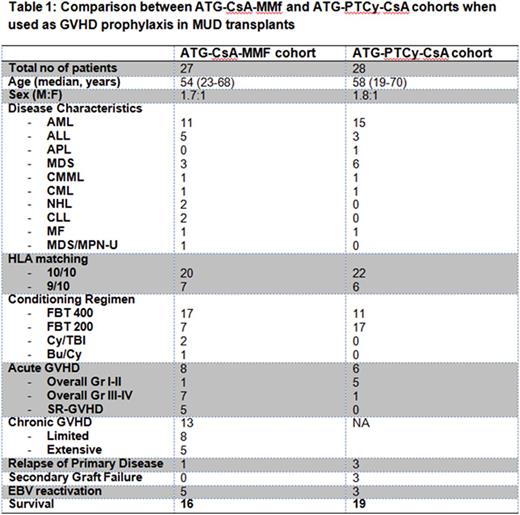Abstract
Introduction: Acute Graft-versus-Host Disease (aGVHD) is a frequent complication of Allogeneic Hematopoietic cell transplants (allo-HCT). It can be lethal with increased morbidity and mortality and can occur in upto 40-50% of allo-HCT. Various agents such as calcineurin inhibitors, anti-metabolites and anti T cell antibodies, have been variably used for GVHD prophylaxis. Use of Post-transplant Cyclophosphamide (PTCy) has recently been used extensively in haplo-identical transplant setting with promising results, but has mainly been used in patients with BM as a stem cell source. In those patients receiving PBSC as a stem cell source, PTCy alone could reduce the risk of acute and chronic GVHD significantly. Anti-Thymocyte Globulin (ATG) has been associated with decrease in chronic but not acute GVHD. As most of our patients use PBSC as a graft source, we hypothesized that combination of ATG and PTCy can reduce the incidence of both acute and chronic GVHD. Since we had also used ATG for GVHD prophylaxis in a historical cohort, we compared the results of this approach with the current GVHD prophylaxis regimen.
Methods: A total of 28 patients with hematological malignancies, who had an unrelated donor underwent allo-HCT at our center from 1 Oct 2015 to 31 Mar 2016. After interim analysis, when increased non-hematological toxicity was observed with myeloablative conditioning, all patients subsequently received reduced intensity conditioning. Peripheral blood was used as a stem cell source in all patients. The GVHD prophylaxis consisted of a combination of ATG-PTCy-CsA, with rabbit ATG administered on Days -3 (0.5 mg/Kg), -2 (2 mg/Kg) and -1 (2 mg/Kg), PTCy at dose of 50 mg/kg on Days +3 and +4 and CsA from Day+5 onwards. Filgrastim was used from day +7 onwards for 13 patients. Emphasis was given to incidence of acute GVHD, especially Steroid Refractory (SR-GVHD).
Results: Out of total of 28 patients, aGVHD was seen in 6 (21.4%) patients, five of which had skin involvement (Grade I- II) and one suspected liver involvement (Grade III), all of which responded rapidly to steroids with no cases of SR-GVHD. Secondary graft failure and EBV reactivations; each were seen in 10% of cases. Primary disease relapse was seen in 3 patients, two of which had minimal residual disease prior to transplantation. These results were then compared to the historical cohort of 27 patients who received a combination of ATG-CsA plus Mycophenolate Mofetil (MMf) (Table 1). The incidence of acute GVHD was 26% vs 22% (p=0.99), with severe Grade III-IV aGVHD of 4% vs 20% (p=0.085) in the ATG-PTCy-CsA and ATG-CsA-MMf cohorts, respectively; both were statistically not signifcant. There were five patients with SR-GVHD in the ATG-CsA-MMf cohort and none in the current GVHD prophylaxis arm. In the historical cohort, the main cause of death in 7 out of 11 patients was severe GVHD as compared to 1 out of 9 in the ATG-PTCy-CsA cohort.
Conclusions: Combination of ATG-PTCy-CsA is an effective strategy to reduce aGVHD; especially severe Grade III-IV and doesnot increase the risk of SR-GVHD, in unrelated donor transplants as compared to ATG-CsA-MMf. However, a long term follow up is needed to assess relapse and cGVHD.
No relevant conflicts of interest to declare.
Author notes
Asterisk with author names denotes non-ASH members.


This feature is available to Subscribers Only
Sign In or Create an Account Close Modal